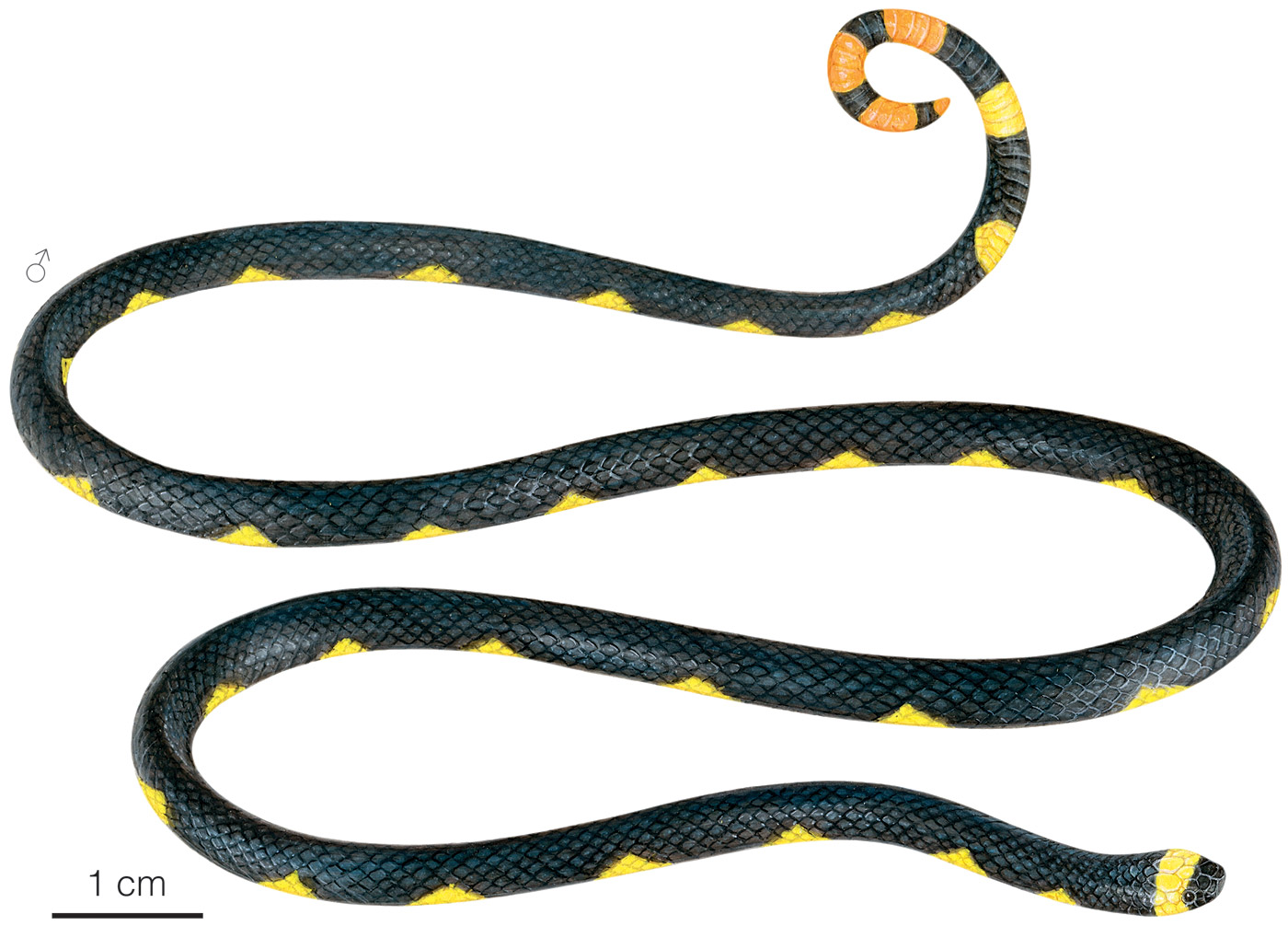Published October 28, 2021. Open access. | Purchase book ❯ |
Pygmy Slender-Coralsnake (Micrurus scutiventris)
Reptiles of Ecuador | Serpentes | Elapidae | Micrurus | Micrurus scutiventris
English common names: Pygmy Slender-Coralsnake, Little Black Coral Snake.
Spanish common names: Coral enana, coral negra pequeña.
Recognition: ♂♂ 37.3 cmMaximum distance from the snout to the tip of the tail. ♀♀ 44.5 cmMaximum distance from the snout to the tip of the tail..1 In Ecuador, Micrurus scutiventris is one of two coralsnakes that lack complete body rings.2 It can be distinguished from most other snakes by its long and slender body, short tail (3.8–5.8% of snout-vent length), and unique coloration.1–3 It has an entirely black dorsum and head, interrupted only by a pale yellow nape band (Fig. 1).1 The ventral surfaces are also black, but have 24–38 bright yellow bands or spots. The tail bears 2–3 bright red bands that may encircle the whole body or be confined to the ventral side.1,3 The only other snake having a similar coloration in Ecuador is M. melanotus. However, individuals of this species have longer bodies and more than 40 red to yellow ventral bands.1

Figure 1: Illustration of an adult male of Micrurus scutiventris based on photographs of specimens from Ecuador and Perú.
Natural history: Micrurus scutiventris is an extremely rare semi-fossorial and cryptozoic snake that inhabits pristine to moderately disturbed rainforests.1–4 Individuals have been seen active on the leaf-litter at night4 or hidden inside termite and ant nests.1 These snakes actively forage in search of prey, which includes burrowing lizards.3 Pygmy Slender-Coralsnakes rely on their camouflage and secretive habits as a primary defense mechanism. They are more calm and docile than other coralsnake species. If disturbed, they engage in complex and seemingly erratic behavior: they hide the head beneath body coils, crawl spasmodically forward and then backward, and display the brightly colored underside of the tail as a decoy.1 They are also capable of striking if provoked. The venom in M. scutiventris is neurotoxic and is probably lethal to humans, but no published records of envenomation exist.1
Conservation: Least Concern Believed to be safe from extinction given current circumstances..5 Micrurus scutiventris is included in this category because the species is widely distributed, occurs in major protected areas, has presumed stable populations, and is currently facing no major widespread extinction threats.5 The most important threat to the long-term survival of some populations is habitat destruction mostly due to mining, oil extraction, and the expansion of the agricultural frontier.1
Distribution: Micrurus scutiventris is native to the western Amazon basin and the adjacent foothills of the Andes in Brazil, Colombia, Ecuador (Fig. 2), and Perú.

Figure 2: Distribution of Micrurus scutiventris in Ecuador. The type locality is Pebas, Perú. See Appendix 1 for a complete list of the presence localities included in the map.
Etymology: The name Micrurus is derived from the Latin words mikros (=small) and oura (=tail), referring to the short tail in members of this group.2 The species epithet scutiventris comes from the Latin words scutum (=scale) and venter (=belly), referring to the number of ventral scales, which is comparatively higher than in other coralsnake species.2
See it in the wild: Pygmy Slender-Coralsnakes are usually found no more than once every few years at any given area. In Ecuador, there are only seven confirmed records (Appendix 1), and in no single locality the species has been spotted more than once. The most recent observation of this species in Ecuador is from Río Bigai Reserve.
Acknowledgments: This account was published with the support of Secretaría Nacional de Educación Superior Ciencia y Tecnología (programa INEDITA; project: Respuestas a la crisis de biodiversidad: la descripción de especies como herramienta de conservación; No 00110378), Programa de las Naciones Unidas (PNUD), and Universidad San Francisco de Quito (USFQ).
Author: Alejandro ArteagaaAffiliation: Fundación Khamai, Reserva Arlequín, Ecoruta Paseo del Quinde km 56, Santa Rosa de Mindo, Pichincha 171202, Ecuador.
Illustrator: Matt Patterson
How to cite? Arteaga A (2021) Pygmy Slender-Coralsnake (Micrurus scutiventris). In: Arteaga A, Bustamante L, Vieira J (Eds) Reptiles of Ecuador: Life in the middle of the world. Available from: www.reptilesofecuador.com. DOI: 10.47051/YBKN2524
Literature cited:
- Valencia JH, Garzón-Tello K, Barragán-Paladines ME (2016) Serpientes venenosas del Ecuador: sistemática, taxonomía, historial natural, conservación, envenenamiento y aspectos antropológicos. Fundación Herpetológica Gustavo Orcés, Quito, 653 pp.
- Campbell JA, Lamar WW (2004) The venomous reptiles of the western hemisphere. Cornell University Press, Ithaca, 774 pp.
- Roze JA (1996) Coral snakes of the Americas: biology, indentification, and venoms. Krieger Publishing Company, Malabar, 328 pp.
- Dixon JR, Soini P (1986) The reptiles of the upper Amazon Basin, Iquitos region, Peru. Milwaukee Public Museum, Milwaukee, 154 pp.
- Gagliardi G, Gonzales L, Nogueira C, Valencia J (2019) Micrurus scutiventris. The IUCN Red List of threatened species. Available from: www.iucnredlist.org. DOI: 10.2305/IUCN.UK.2019-2.RLTS.T44581913A44581920.en
Appendix 1: Locality data used to create the distribution map of Micrurus scutiventris in Ecuador (Fig. 2). Go to the section on symbols and abbreviations for a list of acronyms used.
| Country | Province | Locality | Source |
| Ecuador | Orellana | El Edén | Valencia et al. 2016 |
| Ecuador | Pastaza | Andoas | Campbell & Lamar 2004 |
| Ecuador | Pastaza | Comunidad Puka Yaku | Valencia et al. 2016 |
| Ecuador | Pastaza | Pandanuque | Villamil Gualinga & Shiguango Andi 2008 |
| Ecuador | Pastaza | Sarayacu | Valencia et al. 2016 |
| Ecuador | Sucumbíos | Lumbaqui | Valencia et al. 2016 |
| Ecuador | Sucumbíos | Santa Elena | Valencia et al. 2016 |
| Perú | Amazonas | Nazareth | Campbell & Lamar 2004 |
| Perú | Amazonas | Santa Maria De Nieva | Campbell & Lamar 2004 |